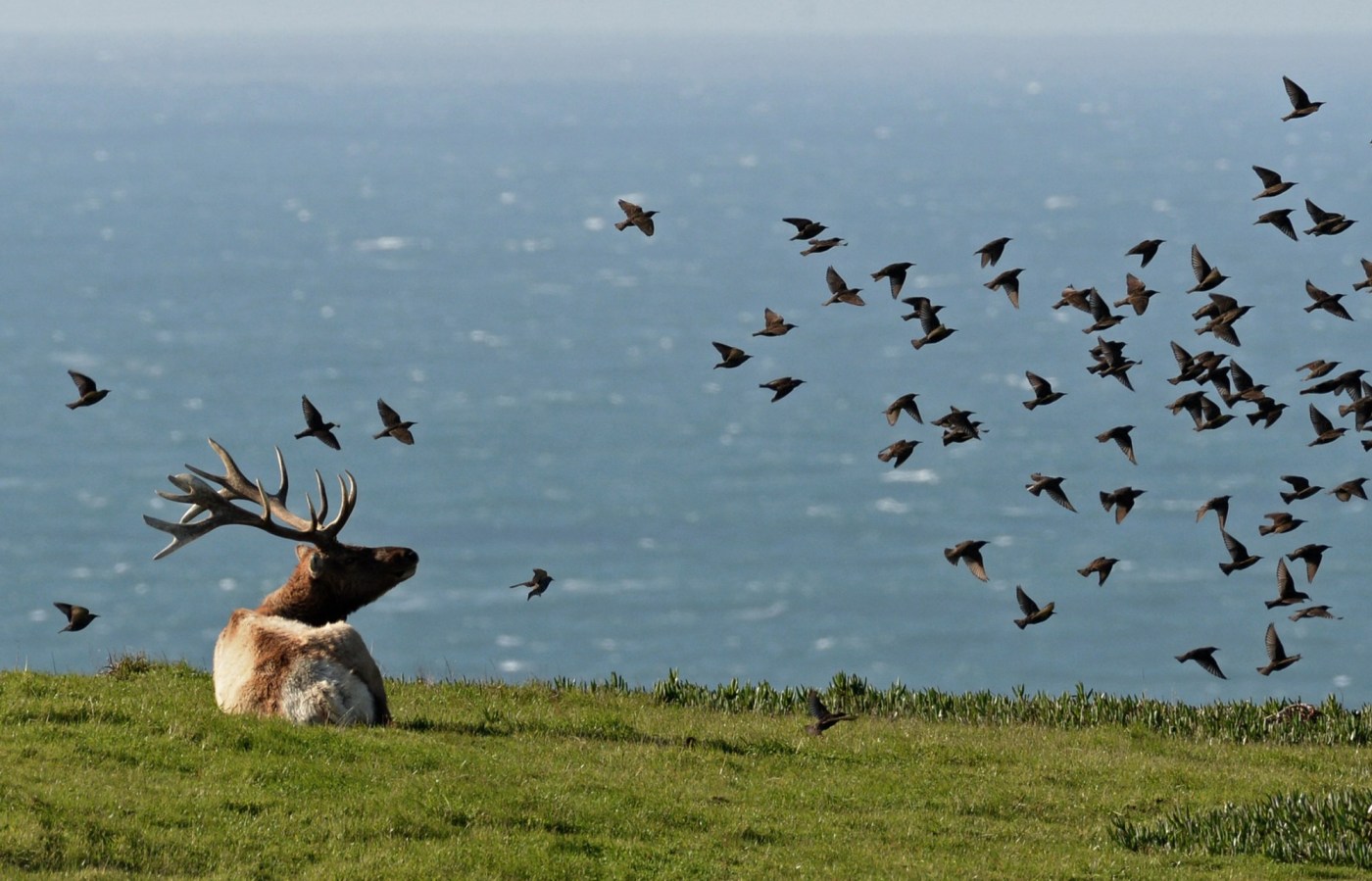A new study suggests a plan to remove a controversial fence to free tule elk in the Point Reyes National Seashore would achieve the park’s preservation goals while still effectively managing the herd.
Related Articles
A strange fungus could transform emerging cicadas into ‘saltshakers of death,’ scientists say
San Jose woman wants to keep the squirrels in her yard, but ditch the rats
Use solar power, kill a tortoise? Climate change solution carries environmental costs
Scores of starving and sick pelicans are found along the California coast
Here’s a great new tool to help protect butterflies in your area
The “Tomales Point Area Plan Environmental Assessment” looks at the potential effects of the proposal to remove the 8-foot tall, 2-mile fence. The plan was pitched after two large die-offs at the 2,900-acre Tomales Point Tule Elk Preserve during droughts.
“Long-term benefits to vegetation would be expected once the elk are able to roam, due to the dilution of the elk population across a broader range,” the report says. “Expansion of the elk range would also provide a source of natural grassland disturbance to the planning area through the elks’ grazing behaviors.”
The National Park Service created the preserve in 1978 to reestablish tule elk in the seashore. The fence was erected to separate the herd from private cattle ranches that lease parkland south of Tomales Point.
Removing the fence is the preferred option of three alternatives the park is considering as part of an update to its 1998 Tule Elk Management Plan, which outlines the management practices of the herd.
An elk fence along Tomales Point on Monday, Sept. 18, 2023, near Inverness, Calif. (Aric Crabb/Bay Area News Group)
The park’s preferred alternative, which the report calls “alternative B,” would also consider adding a different type of fence to keep cattle from private ranches in the park from entering Tomales Point. The park would collaborate with the Federated Indians of Graton Rancheria in the management of the peninsula.
The plan would remove the temporary water systems installed during the drought and provide opportunities for improved recreation and visitor experiences, according to the National Park Service.
The report says the proposal would provide benefits to the elk and black-tailed deer in the area.
“These potential benefits include increased genetic diversity, supporting natural population cycles, better habitat management including the potential use of prescribed fire, and other benefits associated with free-ranging elk herds,” the report said. “Alternative B would most align with creating the desired conditions for the project area and would best support current and future tule elk and black-tailed deer resources.”
The report says the plan would enhance the natural wilderness experience, lessen the need for water supply and reduce grazing pressure and trampling within the preserve area, among other benefits.
“Alternative A” is what is called a no-action alternative, meaning management practices would remain unchanged. “Alternative C” would leave the fence in place, and instead proposes culling the herd for population control. “Alternative C” would achieve many of the same preservation benefits and improved visitor amenities as the preferred option, but it involves lethal intervention.
The report — which was required by the NPS Organic Act and National Environmental Policy Act — was prepared by the National Park Service and consultants.
Public comment on the plan will be collected through 10:59 p.m. June 5. The report and instructions on how to comment are at parkplanning.nps.gov/tpap. Comments can also be sent by letter to Tomales Point Area Plan c/o superintendent, Point Reyes National Seashore, 1 Bear Valley Road, Point Reyes Station, 94956.
An online public meeting is set for 5 p.m. May 22. Registration is at bit.ly/4d780Jl.
Melanie Gunn, a park official, said the National Park Service will make a final decision on the plan this summer after review of public comment.
Tule elk graze in the Tomales Point reserve at Point Reyes National Seashore on Thursday, Sept. 5, 2019. (Alan Dep/Marin Independent Journal)
The Tomales Point herd had large population declines during two recent droughts. The herd declined from 445 elk to 221 between the winters of 2019-2020 and 2020-2021. About 250 elk in the herd died during a previous drought from 2013-2015.
Staff said the die-offs were most likely caused by a lack of forage and poor forage quality and not dehydration. The latest die-off prompted the park service to make the unprecedented decision to place supplementary water tanks and minerals in the preserve in 2021.
The herd had 262 elk during the last count in the winter of 2022-23.
The fence removal plan has been viewed optimistically by environmental groups and activists, some of which have filed litigation in federal court against the park service alleging neglect in response to the Tomales Point herd die-offs.
“It’s a long time coming,” said Chance Cutrano, director of programs for the Resource Renewal Institute, an environmental organization in Fairfax, one of the plaintiffs that sued the park service to challenge the ranch lease extensions.
“It is exciting both because I think it’s a sign that the National Park Service is really taking the threats of the climate crisis into consideration for its future management decision,” Cutrano said.
Secondly, Cutrano said, “this is something the public has been asking for for years. It’s a remarkable achievement of the general public.”
Ashley Eagle-Gibbs, executive director of the nonprofit Environmental Action Committee of West Marin, said her staff is still reviewing the document and meeting with stakeholders to learn more, but they are generally supportive of the preferred option and are opposed to culling.
“This alternative has multiple benefits,” she said. “We look forward to participation in the public process.”
Theresa Harlan is an Indigenous advocate whose Coast Miwok family lived for four generations at Felix Cove, officially known as Laird’s Landing, a secluded area on the Point Reyes peninsula facing Tomales Bay.
“We’re hoping to see the wildlife and the biological diversity flourish,” Harlan said. “We’re hoping to see that the park will soon resemble how our ancestor Coast Miwok intended it to be, in a way that does not damage or harm the ecosystem.”
Ranch owners represented by the Point Reyes Seashore Ranchers Association oppose the fence removal.
In a letter to the park service last year, the association stated the park’s current Tomales Point management plan, adopted in 1998, already considered the removal of the fence and found that it could be done “only after ranching activities terminate.”
The park service approved a ranch management plan in 2021 that would allow it to extend ranching leases from five-year terms to up to 20-year terms.
The letter states ranches are historic and cultural resources the park is charged with protecting, and that the park “should not reconsider the removal of the Tomales Point elk fence because certain members of the public don’t like the fence.”
The historic J Ranch stands outside the Tomales Elk Preserve, in the Point Reyes National Seashore near Inverness on Thursday, Sept. 5, 2019. (Alan Dep/Marin Independent Journal)












